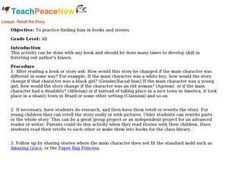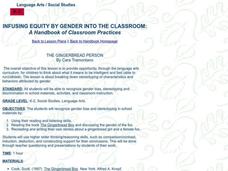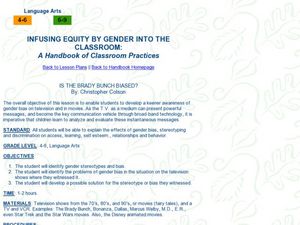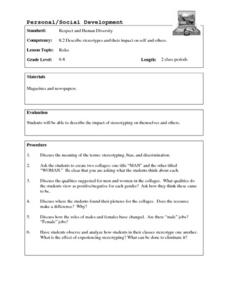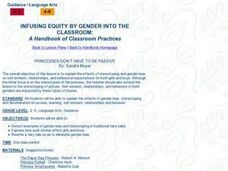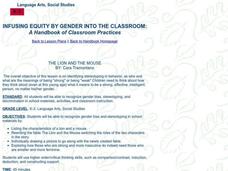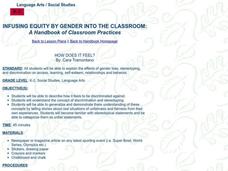Curated OER
"The Story of an Hour" Lesson 1: Teacher's Guide and Notes
Attitudes toward women have changed radically in the last hundred years. The first lesson in a six-part unit that uses Kate Chopin's short story "The Story of an Hour" as an anchor text begins with a shared reading of "The Role of Women...
Curated OER
Retell the Story
Students identify bias in books. In this character education lesson, students read a text and discuss any gender or racial bias which may be present. Students retell and rewrite the story in a fair way.
Curated OER
Fort Wayne's Industrial Girls
Eighth graders explore what life was like for Fort Wayne's "industrial girls." For this industrialization lesson, 8th graders discuss the conditions that the Indiana factory girls worked in as well as their backgrounds. Students also...
Curated OER
How To Do an AP Euro DBQ
Are your AP classes struggling with Document Based Questions? Nip their problems in the bud with this clear and comprehensive presentation, which compares a "dazzling DBQ" to a hamburger, outlining all of the layers therein....
Curated OER
The Gingerbread Person
Learners think about what it means to be intelligent and fast (able to run)/athletic. After listening to the story, 'The Gingerbread Boy,' students write their own stories about a gingerbread girl and a female fox.
Curated OER
Confronting the -Isms
Students keep "Mindwatch" diaries to chart their own prejudices and stereotypes. In this social justice lesson, students monitor their own reactions to people who are different from themselves. Students identify and discuss patterns of...
Curated OER
Depicting Women and Class in a Global Society
Students analyze the evolution of women's work from the 19th century to present day and create artwork depicting women. In this women's roles lesson, students compare and contrast the use of space and color in the two paintings depicting...
Curated OER
Roles
Students discuss the meaning of the words: stereotypes, bias, and discrimination. They create two collages, one for women and one for men. They brainstorm ideas on why they picked the pictures they did.
Curated OER
Women's Roles: Then and Now
Fourth graders investigate women's roles during the frontier era in what is today's West Virginia. In this US history lesson, 4th graders discuss similarities and differences of women's roles in the past with what women's roles are in...
Curated OER
To Kill a Mockingbird by Harper Lee
Use this handy presentation to prepare your class before reading the novel, To Kill a Mockingbird by Harper Lee. Segregation, the stock market, and the sociopolitical climate of the times is covered. This will really help build a...
Curated OER
Whose Is It? (Pronouns and Antecedents)
Define and explore pronouns and antecedents. Young writers read and complete a worksheet using pronouns and correct antecedents. The worksheet is not included but can be easily found online and then dispersed as homework (insert evil...
Curated OER
How Are We Different?
Young scholars discuss the differences between boys and girls. In this acceptance lesson, students view pictures of boys and girls and use a Venn Diagram to chart their differences. Young scholars discuss boy activities and girl...
Curated OER
The Lion and the Mouse
Young scholars write a story. For this critical thinking and writing lesson, students read a fable, answer the provided thinking skills questions, and write their own fable.
Curated OER
Asian Cinderella Tales
Explore the world of fairy tales using this lesson focusing on higher- order thinking skills. Learners compare and contrast an Asian Cinderella story to other versions. It is a great way to review the characteristics of the genre and...
Ontario
Critical Literacy—Media Texts
Media texts convey both overt and implied messages. As part of their study of media, class members analyze the language, form, techniques, and aesthetics in a variety of media texts.
Curated OER
PRINCESSES DON'T HAVE TO BE PASSIVE
Students learn the effects of stereotyping and discrimination.
Curated OER
RIGHT TO EQUAL OPPORTUNITY
Students learn the importance of fairness and come up with strategies to create this type of environment in their classroom.
Curated OER
THE LION AND THE MOUSE
Students listen to a story about different types of animals and explore how they all need each other, just like people do.
Curated OER
HOW TO COMBAT HARASSMENT AND DISCRIMINATION
Students explore discrimination and tell about harassment they have experienced.
Curated OER
HOW DOES IT FEEL?
Students explore how it feels to be discriminated against and explain the concepts of it.
Curated OER
“And Still I Rise” Proud Black Women
Students examine the experiences of African American women. In this poetry instructional activity, students use their literary analysis skills to compare the poetry of Maya Angelou to rap music performed by Queen Latifah and Lauryn Hill.
Curated OER
What Do Halloween Costumes Say?
Students analyze Halloween costumes they find in magazines to categorize their findings. In this holiday lesson, students discuss their findings about the costumes based on four different elements.
Other popular searches
- Gender Bias Statistics
- Gender Bias Lesson Plans
- Gender Bias Activity
- Gender Bias and Stereotyping
- Gender Bias Role Play
- Gender Bias in Education
- Gender Bias Math
- No Gender Bias
- Literature With Gender Bias
- Gender Bias in Psychology
- Gender Bias Language
- Gender Biased Computer Games



